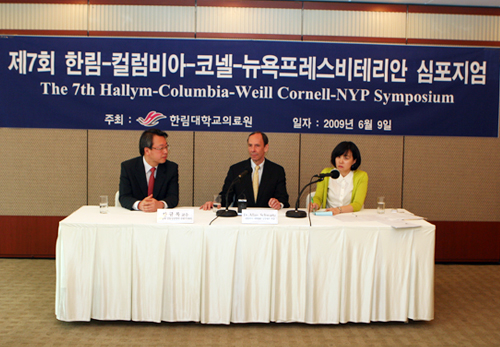Replacing Heart Valve without Open-heart Surgery
No.2130 Date2009-07-02 Hit 33467
Replacing Heart Valve without Open-heart Surgery
No.2130 Date2009-07-02 Hit 33467

"There is no royal road to preventing a heart disease. The best way is to keep your ideal body weight, control stress, exercise regularly, and quit smoking," stressed Dr. Allan Schwartz, professor of cardiology at Columbia University Medical Center(See photo) who served as the physician in charge of former U.S. president Bill Clinton. Dr. Schwartz was invited by Hallym University Medical Center(HUMC) to address at the 7th Hallym-Columbia-Weill Cornell-NYP Symposium held recently in Korea. Prof. Schwartz, a leading U.S. specialist in a valvular heart disease, graduated from Columbia University with a doctorate in medicine in 1974, and has been on the faculty of Columbia University College of Physicians and Surgeons since 1978.
With ageing, more and more people tend to have an aortic valve disorder which restricts adequate blood flow from the heart due to the failure of the function of aortic valve. Dr. Schwartz gave a special lecture on "Percutaneous Aortic Valve Replacement(PAVR)." PAVR is a procedure for patients who are suffering from aortic stenosis, a narrowing of an aortic valve. Instead of performing traditional open-heart surgery, a synthetic valve is transported to the heart through a small hole made in groin. It was first introduced in France in 2002, and is being investigated in a clinical trial in the U.S. "An open-heart surgery requires a cardiopulmonary bypass(CPB) to maintain blood flow to the vital organs, such as brain. The surgery leaves a scar on the chest and takes a long time to be fully recovered." he said. If the patient has aortic valve stenosis and related symptoms, he/she is subject to death or to severe disabilities in three or four years.
Prof. Schwartz also suggested prospects for treating patients with end-stage heart failure. "There are more than 30,000 American patients waiting for heart transplantation, but only 2,000 to 3000 of them can get the chance for transplantation as the number of donors is limited. In the long run, we will be able to develop a mechanic heart which would help transplant all functions, or use stem cells in recovering dying muscle," noted the professor.
Translated by Jonghun Im, Int'l Operations Team, HUMC (imjonghun@hallym.or.kr)